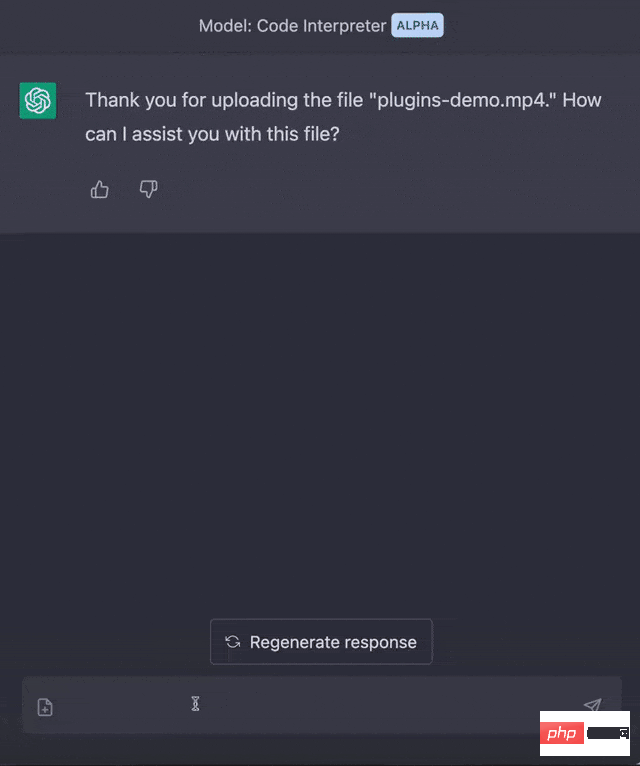
According to news on July 10, OpenAI yesterday announced the full opening of GPT-3.5 Turbo, DALL-E and Whisper APIs to assist developers in improving model processing efficiency. In addition, OpenAI also stated that it is working on Develop follow-up features for GPT-4 and GPT-3.5 Turbo, which are planned to be launched in the second half of this year.
OpenAI revealed that all current AI models called by the API have been upgraded to GPT-4 by default, and existing users can use it without switching.
Note: Whisper API is a speech-to-text AI model that can recognize the user's voice, video and other media and convert it into text.

▲ Picture source OpenAI official website
OpenAI stated that it is constantly improving the Chat Completions API, with the main goal of improving its computing efficiency. They plan to discontinue the obsolete model of the Completions API in January 2024, 6 months later.
Note: Completions API is a natural language processing API that can be used for various text generation tasks, such as generating summaries, translating languages, generating articles, self-service Q&A, etc.
OpenAI claims that developers can still call the Completions API, but starting today, OpenAI will mark "old versions of Completions" as "old APIs" in developer files. OpenAI will focus resources on the Chat Completions API in the future and will no longer expose models using the Completions API.
IT House learned after inquiries that OpenAI stated that it is expected that by January 4, 2024, the old model will be terminated, and the Edits API will also be deactivated. Users of the Edits API and related models must be deactivated in early January next year. From the old model (text-davinci-edit-001 or code-davinci-edit-001) to GPT-3.5 Turbo, OpenAI also lists a comparison table of the old and new models.

▲ Picture source OpenAI
The above is the detailed content of OpenAI has fully opened GPT-3.5 Turbo, DALL-E and Whisper APIs. For more information, please follow other related articles on the PHP Chinese website!
 得益于OpenAI技术,微软必应的搜索流量超过谷歌Mar 31, 2023 pm 10:38 PM
得益于OpenAI技术,微软必应的搜索流量超过谷歌Mar 31, 2023 pm 10:38 PM截至3月20日的数据显示,自微软2月7日推出其人工智能版本以来,必应搜索引擎的页面访问量增加了15.8%,而Alphabet旗下的谷歌搜索引擎则下降了近1%。 3月23日消息,外媒报道称,分析公司Similarweb的数据显示,在整合了OpenAI的技术后,微软旗下的必应在页面访问量方面实现了更多的增长。截至3月20日的数据显示,自微软2月7日推出其人工智能版本以来,必应搜索引擎的页面访问量增加了15.8%,而Alphabet旗下的谷歌搜索引擎则下降了近1%。这些数据是微软在与谷歌争夺生
 ChatGPT出现隐私漏洞,可能泄露用户和聊天机器人的对话标题Apr 07, 2023 pm 11:21 PM
ChatGPT出现隐私漏洞,可能泄露用户和聊天机器人的对话标题Apr 07, 2023 pm 11:21 PMReddit和Twitter上的用户从3月20日开始报告了ChatGPT的一个漏洞,并发布了一些屏幕截图,显示他们的ChatGPT网页历史记录中包含他们不熟悉的对话标题。虽然以这种方式似乎无法访问共享聊天内容,但OpenAI公司在关闭该漏洞时完全删除了聊天历史记录。根据行业媒体的报道,ChatGPT在当天还出现了重大中断,那些可以访问的用户注意到提供了不一致的服务。OpenAI公司在其状态页面上记录了中断情况,并在最初报告的几个小时内恢复了服务。OpenAI公司的首席执行官 Sam Altman
 LLM之战,谷歌输了!越来越多顶尖研究员跳槽OpenAIApr 07, 2023 pm 05:48 PM
LLM之战,谷歌输了!越来越多顶尖研究员跳槽OpenAIApr 07, 2023 pm 05:48 PM前几天,谷歌差点遭遇一场公关危机,Bert一作、已跳槽OpenAI的前员工Jacob Devlin曝出,Bard竟是用ChatGPT的数据训练的。随后,谷歌火速否认。而这场争议,也牵出了一场大讨论:为什么越来越多Google顶尖研究员跳槽OpenAI?这场LLM战役它还能打赢吗?知友回复莱斯大学博士、知友「一堆废纸」表示,其实谷歌和OpenAI的差距,是数据的差距。「OpenAI对LLM有强大的执念,这是Google这类公司完全比不上的。当然人的差距只是一个方面,数据的差距以及对待数据的态度才
 美媒担忧:ChatGPT们生成的摘要足够好,读者不来看新闻怎么办Apr 08, 2023 pm 11:31 PM
美媒担忧:ChatGPT们生成的摘要足够好,读者不来看新闻怎么办Apr 08, 2023 pm 11:31 PM据报道,美国新闻行业正将AI聊天机器人视为一种新的生存威胁。他们担心人们会认为聊天机器人提供的文章摘要已经足够好,从而不再访问他们的网站,致使读者和广告商流失。然而,也有媒体高管认为,尽管存在潜在的威胁,但也有机会。他们正试图在行业变革中领先一步,以适应读者获取信息方式的演变。以下是翻译内容当你向微软Bing聊天机器人询问美国前总统唐纳德·特朗普(Donald Trump)是否被起诉时,它的回答会让传媒高管们感到害怕。机器人给出的三句摘要似乎很有用,它不仅提供了CNN、华盛顿邮报等新闻媒体的链
 CIO分享:企业IT应谨慎使用生成式AI向前发展Apr 11, 2023 pm 03:49 PM
CIO分享:企业IT应谨慎使用生成式AI向前发展Apr 11, 2023 pm 03:49 PMVince Kellen是美国加州大学圣地亚哥分校(UCSD)的首席信息官,他深知ChatGPT、DALL-E和其他生成式AI技术有据可查的局限性:生成的答案可能并不真实,生成的图像也可能缺乏完整性,输出可能存在偏差。但无论如何他都在向前推进,他表示,员工们已经在使用ChatGPT来编写代码和工作内容描述了。OpenAI的文本生成技术ChatGPT以及图像生成技术DALL-E在一系列吸引了公众想象力的大型语言模型(也称为生成语言模型或者生成式AI)中是最突出的,这些模型响应书面请求以生成从文本文
 ChatGPT技术国产化尝试Apr 08, 2023 am 11:31 AM
ChatGPT技术国产化尝试Apr 08, 2023 am 11:31 AM本次分享题目为 ChatGPT 技术、国产化尝试和开源模型。分享包含三大部分的内容,第一部分总体介绍 ChatGPT 相关的技术:ChatGPT 技术的演进、目前存在什么样的问题、ChatGPT 技术学习的三个阶段、数据组织和效果评估;第二部分分享我们在 ChatGPT 技术国产化方面进行的尝试,包含实验过程中我们遇到的问题、进行的思考以及模型的效果和应用;第三部分介绍我们已经发布的中文开源大模型,使用自有数据训练出本地模型如何进行操作,在实验过程中可能遇到的问题,和开源的先进模型相比存在的差距
 用ChatGPT秒建大模型!OpenAI全新插件杀疯了,接入代码解释器一键getApr 04, 2023 am 11:30 AM
用ChatGPT秒建大模型!OpenAI全新插件杀疯了,接入代码解释器一键getApr 04, 2023 am 11:30 AMChatGPT可以联网后,OpenAI还火速介绍了一款代码生成器,在这个插件的加持下,ChatGPT甚至可以自己生成机器学习模型了。 上周五,OpenAI刚刚宣布了惊爆的消息,ChatGPT可以联网,接入第三方插件了!而除了第三方插件,OpenAI也介绍了一款自家的插件「代码解释器」,并给出了几个特别的用例:解决定量和定性的数学问题;进行数据分析和可视化;快速转换文件格式。此外,Greg Brockman演示了ChatGPT还可以对上传视频文件进行处理。而一位叫Andrew Mayne的畅销作
 GPT-4掀起新一轮AI风暴,被围堵的文心一言能否一战?Apr 11, 2023 pm 05:43 PM
GPT-4掀起新一轮AI风暴,被围堵的文心一言能否一战?Apr 11, 2023 pm 05:43 PM将文心一言发布时间定在3月16日的百度,没能预料到会遭到来自OpenAI、谷歌、微软的轮番轰炸:先是3月15日凌晨,OpenAI发布大型多模态Transformer模型GPT-4;紧接着,宣布开放大规模语言模型PaLM的API接口,并推出面向开发者的工具MakerSuite;文心一言发布之后,巨头们也并没有歇着,3月16日晚间,微软更是发布由AI驱动的办公神器Microsoft 365 Copilot,号称让Word、PPT、Excel、OutLook、协同办公软件的生产力都飙增。文心一言对标C


Hot AI Tools

Undresser.AI Undress
AI-powered app for creating realistic nude photos

AI Clothes Remover
Online AI tool for removing clothes from photos.

Undress AI Tool
Undress images for free

Clothoff.io
AI clothes remover

AI Hentai Generator
Generate AI Hentai for free.

Hot Article

Hot Tools

WebStorm Mac version
Useful JavaScript development tools

SAP NetWeaver Server Adapter for Eclipse
Integrate Eclipse with SAP NetWeaver application server.

MantisBT
Mantis is an easy-to-deploy web-based defect tracking tool designed to aid in product defect tracking. It requires PHP, MySQL and a web server. Check out our demo and hosting services.

SublimeText3 Chinese version
Chinese version, very easy to use

Dreamweaver Mac version
Visual web development tools





